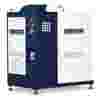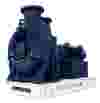What is Aeration in Wastewater Treatment?
Aeration is a technique supporting the biological processes that take place in the second stage of the wastewater treatment (WWT) process.
The pre-filtered wastewater that enters aeration tanks still contains ammonia and very small organic particles that could not be filtered out in the sedimentation tanks.Large amounts of compressed air are introduced into the process via a system of surface or submerged diffusers.
The aim is to feed the microorganisms present in the wastewater and thus effectively remove the waste and pollutants from it.The biological process is energy intensive, but it is a very efficient way of treating wastewater as it may take as little as 5-6 hours.



.png?format=pjpeg&width=100&quality=10)




